Access to a diverse set of AP 10th Class Social Model Papers Set 2 ensures a well-rounded preparation strategy.
AP 10th Class Social Model Paper Set 2 with Solutions
Time: 3.15 hours
Max. Marks: 100
Instructions:
- In the duration of 3 hours, 15 minutes, 15 minutes of time is allotted to read the question paper.
- All answers shall be written in the separate booklet only.
- Question paper consists of 4 Sections and 33 Questions.
- internal choice is available in Section W only.
- Answers shall be written neatly and legibly.
Section – I
12 × 1 = 12 M
Note:
1) Answer all the questions.
2) Each question carries 1 mark.
Question 1.
Expand IPCC.
Answer:
Inter-Governmental Panel on Climate Change
Question 2.
South and Central India has lower water table because …………………. .
Answer:
It has a rocky surface
Question 3.
Himachal Pradesh state is ahead in the Human Development because:
i) Low IMR.
ii) Low literacy rate.
iii) High net attendance rate.
(i) and (ii)
(i) and (iii)
(ii) and (iii)
(i), (ii), and (iii)
Answer:
(i) and (iii)
Question 4.
Give an example to unorganised sector.
Answer:
Building Construction
Question 5.
Based on the relationship between the information in the first pair, complete the second pair.
Eastern Ghats: AroyaKonda :: Western Ghlts: ?
Answer:
Annaimudi
Question 6.
Fill the box with an appropriate word.

Answer:
Factors of production
Question 7.
Identify the person in the given picture.
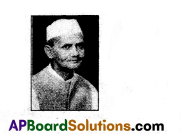
Answer:
Lal Bahadur Shastri
Question 8.
Find the unmatched pair.
i. San-min-chul- Sun Yatsen
ii. China Communist Party – Mao Zedong
iii. Ho Chi Minh – Nigeria
Answer:
Ho Chi Minh – Nigeria (Correct Answer is Ho Chi Minh – Vietnam)
Question 9.
The aim of “Operation Barga’ is ………………. .
Quitting the Britishers from India
To secure share croppers’ rights
Joining the Kashmir in Indian Union
Police action on Hyderabad State
Answer:
To secure share croppers’ rights
Question 10.
He is the first President of India, also the chairman of a constituent assembly. Who is he?
Answer:
Babu Rajendra Prasad.
Question 11.
Who were the members of State Reorganisation Act, 1956?
Answer:
Fazi Ali, K.M.Panikkar and Hridayriath Kunzru.
Question 12.
As per the relation of the information in the first pair, fill the blank.
Siromani Akalidal : Punjab:: DMK : ?
Answer:
Tamil Nadu
Section – II
8 × 2 = 16 M
Note:
1) Answer all the questions.
2) Each question carries 2 marks.
Question 13.
The rise of 2°C in average temperature results in a rise of one meter in sea level by early next century. Write any two slogans on the control of global warming.
Answer:
- Grow trees – Save the earth.
- Avoid plastic bags – Encourage cloth bags.
- Global Warming – A concern of every human being.
Question 14.
Write two suggestions to improve the ranking of India in World Human Development Index.
Answer:
- Providing better employment opportunities to all.
- Providing better health facilities to all.
- Providing educational facilities to all.
Question 15.
What is the main theme of Rachel Carson’s book Silent Spring’?
Answer:
The book ‘Silent Spring’ written by Rachel Carson, explained the impact of spraying DDT (used to control mosquitoes) on humans and birds.
Question 16.
Name the two divisions of the peninsular plateau.
Answer:
The peninsular plateau consists of two broad divisions namely, the central highlands (Malwa Plateau) and the Deccan Plateau.
Question 17.
How did the Election Commission overcome the problem of illiteracy while conducting the first general elections in India?
Answer:
- The Election Commission allotted symbols front everyday life to represent political parties and candidates.
- It allotted each candidate a separate ballot box with the symbol stuck outside.
Question 18.
Write any two benefits of Lok Ada lat in respect of entertaining disputes.
Answer:
- There is no court fee.
- Speedy trial of disputes.
- Procedural flexibility.
- The parties can directly interact with the judge.
Question 19.
What is meant by “Pan – Africanism”?
Answer:
It is an ideology and movement that encourages the solidarity of Africans worldwide. It is based on the belief that unity is vital to economic social and political progress and aims to ‘unify and uplift the people of African descent.
Question 20.
What is your opinion on the Hitler’s treatment of the Jews in Germany?
Answer:
The treatment of Hitler towards Jews is very cruel and unjust.
Section – III
8 x 4 = 32 M
Note:
1) Answer all the questions.
2) Each question carries 4 marks.
Question 21.
What do you learn from the schooling revolution in Himachal Pradesh?
Answer:
- Both the government and the people of Himachal Pradesh were keen on education.
- They started many schools.
- They made sure that education was largely free.
- They allocated a good share of education in the government budget.
- They tried to ensure that the schools had all the facilities.
- Most of the students enjoyed their schooling experience.
Question 22.
Study the following graph and answer the given questions.
a) In which year, the highest sex – ratio was recorded?
b) Identify the reasons for low sex – ratio m India.

Answer:
a) In 1951 the highest and in 1991 the lowest sex – ratio were recorded.
b) Illiteracy and gender discrimination are the reasons for low sex ratio.
Question 23.
Convert the information given below into a pie chart (rough diagram). Write your observation.
| Type of farmers | Percentage of cultivated area |
| Small farmers | 48% |
| Medium and large farmers | 52% |
Answer:
While major part of land (52%) is under control of medium and large farmers, minor part of land (48%) is under the control of small farmers whose number is bigger.
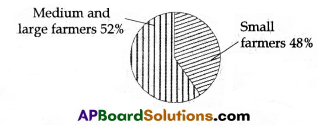
Question 24.
Describe the adverse impacts of urbanisation on environment?
Answer:
There are a lot of problems occurring in the urban areas. They are:
- Scarcity of space and housing problems.
- Increase of slum areas.
- Increase of air, water, and soil pollution.
- Increase in traffic problem.
- Shortage of food items.
- Increase of sewage problem.
- Increase of plastic waste.
- Pressure on environment.
Question 25.
Explain the role played by Sardar Vallabhai Patel in the Unification of states.
Answer:
- With firm determination, Vallabhbhai Patel took up the work of joining princely states in India.
- He made it clear that If the princely states did not join India, the army would have to be sent to complete the process of unification.
- The states Kashmir, Hyderabad, and Junagadh which earlier opposed, too were brought to join India.
- Sardar Vallabhhhai Patel deserves the title ‘Iron Man’ as he was the person that made India a strong union of states.
Question 26.
What are the basic features of social movement?
Answer:
- Social movements have been a powerful means for ordinary people to participate directly in creating positive social change.
- They are deeply grounded in our founding values of security, culture, justice, democracy, civil rights, etc.
- Social movements have raised diverse demands cutting across strict boundary of environment establishing equality.
- Most of the social movements are non-violent and often distant from individual political parties and are more united under a single cause. For all these conditions we can appreciate the basic features of the social movements.
- Social movements must be non-violent.
Question 27.
What did the first Two Five year plan focus on?
Answer:
- First Five-year plan focussed on improving agriculture.
- Second Five-year plan emphasised industries.
Question 28.
Study the map and answer the question that follows.
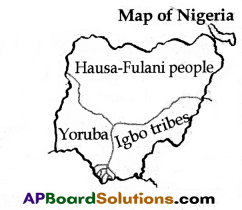
Q. How were the British able to implement their ‘divide and rule’ policy in Nigeria?
Answer:
1. There are three major tribal groups in Nigeria.
- Hausa – Fulani;
- Yoruba;
- Igbo
2. The British were able to implement the divide-and-rule policy in Nigeria by encouraging competition and conflict among these three groups.
Section-IV
5 x 8 = 40 M
Note:
1) Answer all the questions.
2) Each question carries 8 marks.
3) Each question has internal choice.
4) In question no.33, both A and B (India map and World map) should be answered separately.
Question 29.
A) Describe any four of major relief divisions of Indian land mass.
(OR)
B) What is the meaning of international migration? Identify the reasons and consequences of it.
Answer:
A)
I. Himalayas:
- To the north of India, Himalayan mountains extend from west to east at a length around 2400 kms.
- There are three parallel ranges viz Himadri, Himachal, and Shivaliks.
II. Indo-Gangetic Plains:
- The Indo-Gangetic Plain is formed with the interaction of the rivers Ganga, Indus, Brahmaputra and their tributaries.
- These fertile alluvial plains are suitable for agriculture.
III. Peninsular Plateau:
- The Indian plateau is also known as the peninsular plateau as it is surrounded by the sea on the three sides.
- It is broadly divided into two parts: Malwa Plateau and Deccan Plateau.
IV. Coastal Plains:
- The Western coastal plain is extended between Western Ghats and Arabian Sea. The East coastal plain is extended between Eastern Chats and Bay of Bengal.
- These coastal plains are known locally by different names.
Eg: Coast of AP – Circar Coast
Coast of Kerala – Malabar Coast.
B) Migration of the people from one country to other countries due to various reasons is called ‘international migration.
Reasons:
- For higher education.
- For better employment opportunities.
- For business needs.
Consequences:
- The financial conditions of the migrant families improve.
- They are able to pay back loans and buy, assets.
- Changes occur in their lifestyle.
- Brain drain has become a major hazard to the progress of country’s economy.
Question 30.
A) “While service sector has grown, all service sector activities are not growing equally well. Service sector in India employs many different kinds of people. At one end there are a limited number of services that employ highly skilled and educated workers. At the other end, there are a very large number of workers engaged in services such as small shopkeepers, repair persons, transport persons, etc. These people barely manage to earn a living and yet they perform these services because no alternative opportunities for work are available to them.
(OR)
B) “While globalization has benefited well-off consumers and also producers with skill, education and wealth, on the other hand, many small producers and workers have suffered as a result of the rising competition.” Do you agree with the statement? Explain.
Answer:
A)
- It can not be considered that total people working in service sectors have happy life conditions. It depends on whether they are working in organised service sector or unorganised service sector.
- People like technically skilled working in MNCs like Infosys, Wipro, T.C.S etc can be said a working in organised service sector. They enjoy good benefits like minimum weekly holidays, P.Fs, bonuses, etc.
- But people like tailors, small vendors, call centre workers who too come under service sector but are in unorganised sectors do not have fixed income and other benefits.
- It shows that the life conditions of all the people in service sector are not the same.
B)
- Yes, I agree with the statement given.
- The benefits of globalization have been unevenly distributed in India.
- People get a variety of goods.
- They get the opportunity to get goods at competitive prices.
- But the small manufacturers have practically perished due to the competition brought in by globalization.
- It is mainly beneficial to large capitalists, industries, and large companies.
- Consequently. it increased the concentration of economic power and led to large-scale economic inequalities.
- Flexibility in labour laws has worsened the conditions of workers because they are appointed on a non-regular basis to avoid facilities such as provident fund. Job opportunities have increased only for skilled and educated people.
- Only a few companies have successfully made collaborated with foreign companies or emerged as multinationals. There are a number of industries such as toys, tires, batteries, etc. where the small companies have been hit hard by stiff foreign competition.
Question 31.
A) Plot the below information on a Bar graph (Rough diagram).
| Period of time | Number of amendments made to the Constitution |
| 1951-1960 | 7 |
| 1961-1970 | 15 |
| 1971-1980 | 22 |
| 1981-1990 | 22 |
| 1991-2000 | 16 |
| 2001-2013 | 17 |
(OR)
B) Observe the information given in the graph and write a few sentences analysing it.
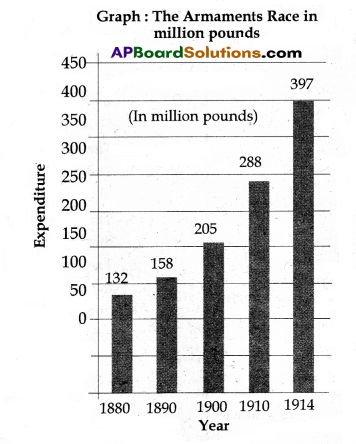
Answer:

B)
- In 19th century the military expenditure raised slowly.
- But during the 20th century, it raised rapidly.
- Before the first World War, the expenditure increased to its maximum level.
- Within four years i.e., between 1910-1914 the expenditure increased nearly by 109 million pounds.
- In the decade of 1880-1890, the raise of expenditure was 26 million pounds only.
Question 32.
A) Suggest measures for better democracy and ethical governance.
(OR)
B) Give suggestions to solve the differences among the countries of Non – Aligned Movement.
Answer:
A)
- Every voter must vote.
- Voters should elect honest candidates.
- The elected representative should be accountable.
- There should be transparency.
- Social Audit is a must.
- Implementation of Recall system is needed.
- Strict implementation of anti-defection law.
- Voters should be literate.
- The society should created awareness on importance of democracy.
B)
- Respect for each other’s sovereignty and territorial integrity.
- Non – interference in the internal affairs of other countries.
- Non – aggression and settlement of disputes with mutual understanding.
- Achieving mutual respect and cooperation.
- Promoting peaceful co-existence.
Question 33.
A) Locate the following in the given outline map of India.
a)
1. The youngest folded mountains.
2. The triangular plateau.
3. The most densely populated state.
4. The largest peninsular river.
(OR)
b)
1. The capital of Meghalaya.
2. The Prime Meridian of India.
3. Konkan coast.
4. Chotanagpur plateau.
Answer:
A)
a)
- Himalayas
- Deccan plateau
- Bihar
- Godavari
(Or)
b)
- Shillong
- 82° 30 E longitude
- Konkan coast.
- Chota Nagpur plateau.
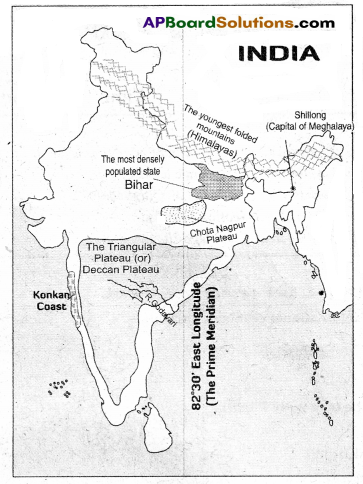
B)
a) Locate and label any four of the permanent members of United Nations Security Council on the World map given. 4 M
(OR)
b) Point out the following countries on the World map given.
1. Portugal
2. Nigeria
3. Chile
4. Japan
Answer:
a)
- USA
- USSR
- France
- China
(Or)
- Portugal
- Nigeria
- Chile
- Japan
